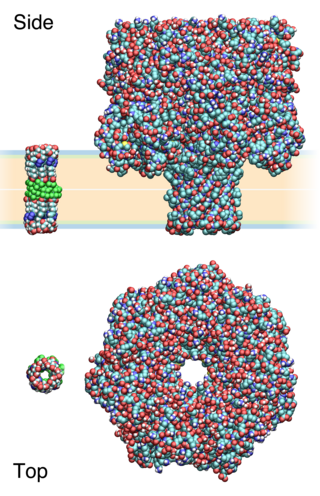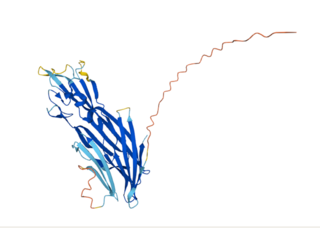Related Research Articles

A nanopore is a pore of nanometer size. It may, for example, be created by a pore-forming protein or as a hole in synthetic materials such as silicon or graphene.

Nanopore sequencing is a third generation approach used in the sequencing of biopolymers — specifically, polynucleotides in the form of DNA or RNA.

The P2X receptors, also ATP-gated P2X receptor cation channel family, is a protein family that consists of cation-permeable ligand-gated ion channels that open in response to the binding of extracellular adenosine 5'-triphosphate (ATP). They belong to a larger family of receptors known as the ENaC/P2X superfamily. ENaC and P2X receptors have similar 3-D structures and are homologous. P2X receptors are present in a diverse array of organisms including humans, mouse, rat, rabbit, chicken, zebrafish, bullfrog, fluke, and amoeba.

Dystroglycan is a protein that in humans is encoded by the DAG1 gene.

Pore-forming proteins are usually produced by bacteria, and include a number of protein exotoxins but may also be produced by other organisms such as apple snails that produce perivitellin-2 or earthworms, who produce lysenin. They are frequently cytotoxic, as they create unregulated pores in the membrane of targeted cells.
Cell-penetrating peptides (CPPs) are short peptides that facilitate cellular intake and uptake of molecules ranging from nanosize particles to small chemical compounds to large fragments of DNA. The "cargo" is associated with the peptides either through chemical linkage via covalent bonds or through non-covalent interactions.

Hemolysins or haemolysins are lipids and proteins that cause lysis of red blood cells by disrupting the cell membrane. Although the lytic activity of some microbe-derived hemolysins on red blood cells may be of great importance for nutrient acquisition, many hemolysins produced by pathogens do not cause significant destruction of red blood cells during infection. However, hemolysins are often capable of lysing red blood cells in vitro.

Nanofluidics is the study of the behavior, manipulation, and control of fluids that are confined to structures of nanometer characteristic dimensions. Fluids confined in these structures exhibit physical behaviors not observed in larger structures, such as those of micrometer dimensions and above, because the characteristic physical scaling lengths of the fluid, very closely coincide with the dimensions of the nanostructure itself.
Light-gated ion channels are a family of ion channels regulated by electromagnetic radiation. Other gating mechanisms for ion channels include voltage-gated ion channels, ligand-gated ion channels, mechanosensitive ion channels, and temperature-gated ion channels. Most light-gated ion channels have been synthesized in the laboratory for study, although two naturally occurring examples, channelrhodopsin and anion-conducting channelrhodopsin, are currently known. Photoreceptor proteins, which act in a similar manner to light-gated ion channels, are generally classified instead as G protein-coupled receptors.

Alpha-toxin, also known as alpha-hemolysin (Hla), is the major cytotoxic agent released by bacterium Staphylococcus aureus and the first identified member of the pore forming beta-barrel toxin family. This toxin consists mostly of beta-sheets (68%) with only about 10% alpha-helices. The hly gene on the S. aureus chromosome encodes the 293 residue protein monomer, which forms heptameric units on the cellular membrane to form a complete beta-barrel pore. This structure allows the toxin to perform its major function, development of pores in the cellular membrane, eventually causing cell death.

Small ubiquitin-related modifier 1 is a protein that in humans is encoded by the SUMO1 gene.

Frizzled-6(Fz-6) is a protein that in humans is encoded by the FZD6 gene.

Sterol O-acyltransferase 1, also known as SOAT1, is an enzyme that in humans is encoded by the SOAT1 gene.
Jeremy Randall Knowles was a professor of chemistry at Harvard University who served as dean of the Harvard University faculty of arts and sciences (FAS) from 1991 to 2002. He joined Harvard in 1974, received many awards for his research, and remained at Harvard until his death, leaving the faculty for a decade to serve as Dean. Knowles died on 3 April 2008 at his home.

Synthetic ion channels are de novo chemical compounds that insert into lipid bilayers, form pores, and allow ions to flow from one side to the other. They are man-made analogues of natural ion channels, and are thus also known as artificial ion channels. Compared to biological channels, they usually allow fluxes of similar magnitude but are
- minuscule in size,
- diverse in molecular architecture, and
- may rely on diverse supramolecular interactions to pre-form the active, conducting structures.

Ammonia transporters are structurally related membrane transport proteins called Amt proteins in bacteria and plants, methylammonium/ammonium permeases (MEPs) in yeast, or Rhesus (Rh) proteins in chordates. In humans, the RhAG, RhBG, and RhCG Rhesus proteins constitute solute carrier family 42 whilst RhD and RhCE form the Rh blood group system. The three-dimensional structure of the ammonia transport protein AmtB from Escherichia coli has been determined by x-ray crystallography revealing a hydrophobic ammonia channel. The human RhCG ammonia transporter was found to have a similar ammonia-conducting channel structure. It was proposed that the erythrocyte Rh complex is a heterotrimer of RhAG, RhD, and RhCE subunits in which RhD and RhCE might play roles in anchoring the ammonia-conducting RhAG subunit to the cytoskeleton. Based on reconstitution experiments, purified RhCG subunits alone can function to transport ammonia. RhCG is required for normal acid excretion by the mouse kidney and epididymis.
Sheena Elizabeth Radford FRS FMedSci is a British biophysicist, and Astbury Professor of Biophysics in the Astbury Centre for Structural Molecular Biology, School of Molecular and Cellular Biology at the University of Leeds. Radford is the Associate Editor of the Journal of Molecular Biology.
Oxford Nanopore Technologies plc is a UK-based company which develops and sells nanopore sequencing products for the direct, electronic analysis of single molecules.

Gideon John Davies is a professor of chemistry in the Structural Biology Laboratory (YSBL) at the University of York, UK. Davies is best known for his ground-breaking studies into carbohydrate-active enzymes, notably analysing the conformational and mechanistic basis for catalysis and applying this for societal benefit. In 2016 Davies was appointed the Royal Society Ken Murray Research Professor at the University of York. Gideon Davies has recently been elected to the Council of the Royal Society.

Cytotoxin-K (CytK) is a protein toxin produced by the gram-positive bacteria Bacillus cereus. It was first discovered in a certain Bacillus cereus strain which was isolated from a food poisoning epidemic that occurred in a French nursing home in 1998. There were six cases of bloody diarrhea, three of which were fatal. None of the known enterotoxins from B. cereus could be detected at this time. Later, this B. cereus strain and its relatives were classified as a brand-new species called Bacillus cytotoxicus, which is the thermo-tolerant member of the B. cereus genus. The cytotoxin-K gene is present in approximately 50% of Bacillus cereus isolates, and its expression is regulated by several factors, including temperature and nutrient availability.
References
- 1 2 3 4 "BAYLEY, Prof. (John) Hagan (Pryce)" . Who's Who . Vol. 2014 (online edition via Oxford University Press ed.). A & C Black.(Subscription or UK public library membership required.)
- ↑ Branton, D.; Deamer, D. W.; Marziali, A.; Bayley, H.; Benner, S. A.; Butler, T.; Di Ventra, M.; Garaj, S.; Hibbs, A.; Huang, X.; Jovanovich, S. B.; Krstic, P. S.; Lindsay, S.; Ling, X. S.; Mastrangelo, C. H.; Meller, A.; Oliver, J. S.; Pershin, Y. V.; Ramsey, J. M.; Riehn, R.; Soni, G. V.; Tabard-Cossa, V.; Wanunu, M.; Wiggin, M.; Schloss, J. A. (2008). "The potential and challenges of nanopore sequencing". Nature Biotechnology. 26 (10): 1146–1153. doi:10.1038/nbt.1495. PMC 2683588 . PMID 18846088.
- 1 2 3 http://royalsociety.org/people/hagan-bayley/ Hagan Bayley at the Royal Society
- 1 2 3 4 "CURRICULUM VITAE Hagan Bayley" (PDF). Retrieved 26 February 2018.
- ↑ http://bayley.chem.ox.ac.uk/ Bayley group at the University of Oxford
- ↑ http://research.chem.ox.ac.uk/hagan-bayley.aspx Hagan Bayley Research page
- ↑ Hagan Bayley's publications indexed by the Scopus bibliographic database. (subscription required)
- ↑ Braha, O.; Braha, H.; Conlan, L. Q.; Cheley, S.; Bayley, S. (1999). "Stochastic sensing of organic analytes by a pore-forming protein containing a molecular adapter". Nature. 398 (6729): 686–690. Bibcode:1999Natur.398..686G. doi:10.1038/19491. PMID 10227291. S2CID 4366779.
- ↑ Lou, H; Chen, M; Black, S. S.; Bushell, S. R.; Ceccarelli, M; Mach, T; Beis, K; Low, A. S.; Bamford, V. A.; Booth, I. R.; Bayley, H; Naismith, J. H. (2011). "Altered antibiotic transport in OmpC mutants isolated from a series of clinical strains of multi-drug resistant E. Coli". PLOS ONE. 6 (10): e25825. Bibcode:2011PLoSO...625825L. doi: 10.1371/journal.pone.0025825 . PMC 3203869 . PMID 22053181.
- ↑ Bayley, Hagan (1979). Adamantylidene: A Hydrophobic, Photogenerated Reagent for the Characterization of Intrinsic Membrane Proteins (PhD thesis). Harvard University. ProQuest 302912373.
- ↑ Bayley2009-05-29T18:07:20+01:00, Hagan. "Nanopores for thought". Chemistry World. Retrieved 22 January 2021.
{{cite web}}: CS1 maint: numeric names: authors list (link) - ↑ Howorka, S.; Cheley, S.; Bayley, H. (2001). "Sequence-specific detection of individual DNA strands using engineered nanopores". Nature Biotechnology. 19 (7): 636–639. doi:10.1038/90236. PMID 11433274. S2CID 447980.
- ↑ Bayley, Hagan Profile at the University of Oxford Archived 17 January 2010 at the Wayback Machine
- ↑ Song, L.; Hobaugh, M. R.; Shustak, C.; Cheley, S.; Bayley, H.; Gouaux, J. E. (1996). "Structure of Staphylococcal alpha -Hemolysin, a Heptameric Transmembrane Pore". Science. 274 (5294): 1859–1865. Bibcode:1996Sci...274.1859S. doi:10.1126/science.274.5294.1859. PMID 8943190. S2CID 45663016.
- ↑ Hagan Bayley publications indexed by Google Scholar
- ↑ Bayley, Hagan Profile at Hertford College
- ↑ Wales, The Learned Society of. "Hagan Bayley". The Learned Society of Wales. Retrieved 22 August 2023.
- ↑ "The UK's 100 leading practising scientists". 17 January 2014.